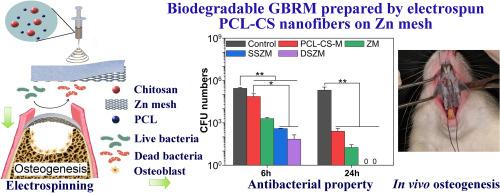锌网上的电纺聚己内酯-壳聚糖纳米纤维作为可生物降解的引导骨再生膜,具有更强的机械、抗菌和成骨特性,可用于牙槽骨修复。
IF 9.6
1区 医学
Q1 ENGINEERING, BIOMEDICAL
引用次数: 0
摘要
引导骨再生膜(GBRM)可阻断成纤维细胞增殖并为骨缺损空间提供空间支持,因此常用于骨修复手术。然而,由于需要进行移除手术,而且传统的 GBRM 缺乏抗菌特性,因此限制了其对牙槽骨缺损的治疗适用性。在这里,我们通过在锌网表面双面电纺聚己内酯和壳聚糖层(简称 DSZM),开发出了一种用于牙槽骨修复和再生的 GBRM。DSZM 的 UTS 为 ∼25.6 MPa,伸长率为 ∼16.1%,强度-伸长率乘积为 ∼0.413 GPa%,具有超高的空间维持能力,其 UTS 是商用 Bio-Gide 膜的 6 倍以上。在 Hanks 溶液中浸泡 1 个月后,DSZM 的腐蚀速率为 ∼17 µm/y,锌离子浓度为 ∼0.23 μg/ml。DSZM 具有直接和间接的细胞相容性,对 MC3T3-E1 细胞具有特殊的成骨分化和钙沉积作用。此外,在大鼠临界大小的上颌骨缺损模型中,DSZM 对金黄色葡萄球菌和成骨作用表现出了很强的持续抗菌活性。总之,DSZM 作为一种可生物降解的 GBRM 材料,具有空间支撑性、适宜的降解性、细胞相容性、抗菌和成骨能力,符合牙槽骨修复和再生应用的要求。意义说明:本研究报告了电纺 PCL-CS 纳米纤维在 Zn 网布上的机械性能、抗菌能力和成骨特性,并将其作为生物可降解的引导骨再生膜用于牙槽骨修复应用。我们的研究结果表明,在 Zn 网布上双面电纺 PCL-CS 层制备的 DSZM 的 UTS 为 ∼25.6 MPa,伸长率为 ∼16.1%,强度-伸长乘积为 ∼0.413 GPa%,具有超高的空间维持能力,其 UTS 是商用 Bio-Gide® 膜的 6 倍以上。DSZM 具有直接和间接的细胞相容性,对 MC3T3-E1 细胞具有优异的成骨分化和钙沉积能力。此外,在大鼠临界大小的上颌骨缺损模型中,DSZM 对金黄色葡萄球菌和成骨作用表现出强烈的持续抗菌活性。本文章由计算机程序翻译,如有差异,请以英文原文为准。

Electrospun polycaprolactone-chitosan nanofibers on a zinc mesh as biodegradable guided bone-regeneration membranes with enhanced mechanical, antibacterial, and osteogenic properties for alveolar bone-repair applications
Guided bone-regeneration membrane (GBRM) is commonly used in bone-repair surgery because it blocks fibroblast proliferation and provides spatial support in bone-defect spaces. However, the need for removal surgery and the lack of antibacterial properties of conventional GBRM limit its therapeutic applicability for alveolar bone defects. Here we developed a GBRM for alveolar bone-repair and -regeneration applications through double-sided electrospinning of polycaprolactone and chitosan layers on a Zn mesh surface (denoted DSZM). The DSZM showed a UTS of ∼25.6 MPa, elongation of ∼16.1%, strength-elongation product of ∼0.413 GPa%, and ultrahigh spatial maintenance ability, and the UTS was over 6 times higher than that of commercial Bio-Gide membrane. The DSZM exhibited a corrosion rate of ∼17 µm/y and a Zn ion concentration of ∼0.23 µg/ml after 1 month of immersion in Hanks’ solution. The DSZM showed direct and indirect cytocompatibility with exceptional osteogenic differentiation and calcium deposition toward MC3T3-E1 cells. Further, the DSZM showed strongly sustained antibacterial activity against S. aureus and osteogenesis in a rat critical-sized maxillary defect model. Overall, the DSZM fits the requirements for alveolar bone-repair and -regeneration applications as a biodegradable GBRM material due to its spatial support, suitable degradability, cytocompatibility, and antibacterial and osteogenic capabilities.
Statement of significance
This work reports the mechanical properties, antibacterial ability and osteogenic properties of electrospun PCL-CS nanofiber on Zn mesh as biodegradable guided bone-regeneration membrane for alveolar bone-repair applications. Our findings demonstrate that the DSZM prepared by double-sided electrospinning of PCL-CS layers on Zn mesh showed a UTS of ∼25.6 MPa, elongation of ∼16.1%, strength-elongation product of ∼0.413 GPa%, and ultrahigh spatial maintenance ability, and the UTS was over 6 times greater than that of commercial Bio-Gide® membrane. The DSZM showed direct and indirect cytocompatibility with exceptional osteogenic differentiation and calcium deposition toward MC3T3-E1 cells. Further, the DSZM showed strongly sustained antibacterial activity against S. aureus and osteogenesis in a rat critical-sized maxillary defect model.
求助全文
通过发布文献求助,成功后即可免费获取论文全文。
去求助
来源期刊

Acta Biomaterialia
工程技术-材料科学:生物材料
CiteScore
16.80
自引率
3.10%
发文量
776
审稿时长
30 days
期刊介绍:
Acta Biomaterialia is a monthly peer-reviewed scientific journal published by Elsevier. The journal was established in January 2005. The editor-in-chief is W.R. Wagner (University of Pittsburgh). The journal covers research in biomaterials science, including the interrelationship of biomaterial structure and function from macroscale to nanoscale. Topical coverage includes biomedical and biocompatible materials.
 求助内容:
求助内容: 应助结果提醒方式:
应助结果提醒方式:


